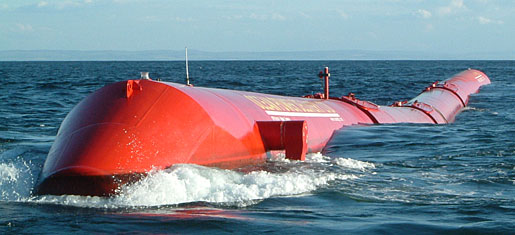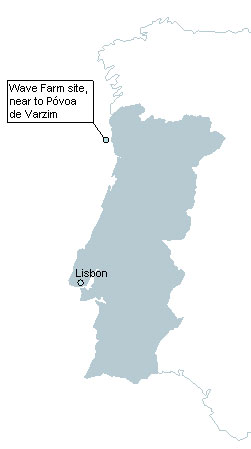Renewable surf energy; Wave farm to harvest electricity from sea swells [photos]
Hydro press release
By David Burke
May 21, 2005
Hydro’s [web site] investment in Scots start-up Ocean Power Delivery caught a commercial wave this week by signing an order with Portuguese energy company Enersis to build the worlds first commercial wave farm to harvest electricity from sea swells.
Located some five kilometers off Portugal’s northern coast, near Póvoa de Varzim, the EUR 8 million project will use three OPD-developed Pelamis P-750 wave power generation units, capable of producing some 2.25MW. Planned for completion in 2006, the farm will initially supply some 1,500 Portuguese households with electricity – and displace more than 6,000 tonnes of CO2 emissions that would otherwise be produced by conventional hydrocarbon-fuelled power plants.
 ENERGY EMERGING: Pelamis wave energy converters rock with the sea (up, down and side-to-side) pumping high-pressure fluid to hydraulic motors that drive electrical generators which produce power fed down umbilical cables to a single subsea cable to shore, where it is tied into the land-based power grid. |
A letter of intent has also been issued to order a further 30 Pelamis machines (for a total 20MW) before the end of 2006, subject to satisfactory performance of the initial project phase. If all goes well, many additional sites producing up to a total several hundred MW could be developed along the coast.
 Pelamis in Portugal |
“This is a major achievement by OPD who have moved from having a seventh-scale model when we invested three years ago to being the leading company in wave energy today, with Pelamis the only concept recognized by EPRI, the US Electric Power Research Institute,” says Richard Erskine, head of Technology Ventures in Hydro.
OPD is also in active discussion with Scottish Power, which has announced its interest in installing a wave farm in the UK.
Pelamis in Portugal
The project is being supplied by Ocean Power Delivery Portugal S.A., a wholly owned subsidiary of OPD with full rights to manufacture Pelamis machines in Portugal. The prototype for the Portuguese project was launched in February 2004 and currently undergoes testing at the European Marine Energy Center in the Orkney Islands.
“This is a significant milestone for our company and for wave energy,” says OPD managing director, Richard Yemm. “We see this order as just the first step in developing the Portuguese market, which is anticipated to be worth up to a billion Euros over the next 10 years.”
Renewables wave
The EU currently calls for 22 percent of electricity consumption to come from renewable sources in 2010. Renewables currently meet about six percent of European energy demand.
 WAVE POTENTIAL: The illustration shows how OPD envisages placing Pelamis units in offshore wave power farms. |
Enersis counts 17 and nine years experience, respectively, developing and operating mini-hydropower projects and wind farms in Portugal. According to its chairman, Gonçalo Serras Pereira, “we believe wave energy will be the new indigenous renewable resource in Portugal. This move in conjunction with other potential partners may win significant industrial economic benefits for Portuguese companies as the market is developed and wave energy gains a competitive advantage with other renewables.”
Funding the future
Hydro’s venture vehicle for the oil and energy industry, Technology Ventures was set up in March 2001, with an initial funding of NOK 350 million (EUR 45 million) to invest in companies developing technologies related to Hydro’s oil and energy operations.
Based in Edinburgh, OPD has been developing the Pelamis technology for seven years. It receives financial support from the UK energy ministry, and investors Hydro, Sustainable Asset Management, the Carbon Trust and 3i plc.
Learn more at Norsk Hydro
Riding waves of energy
Hydro press release
By David Burke
(2004-02-25) Hydro’s dedication to developing renewable power caught a big wave off the coast of Scotland this week with the launch of a 120 meter-long wave power prototype – designed and built by Scots energy technology start-up Ocean Power Delivery.
“A significant part of the UK’s electricity can potentially be met by wave power,” says OPD business development director Max Carcas. “There’s enough wave energy off Britain’s coastline to provide three times its consumption (some 350 TWh in 2002). We estimate some five to eight percent of that can be economically realized.”
The World Energy Council predicts wave power can eventually supply 15 percent of current global energy demand.
Power potential
Technology Ventures in Hydro recognized the potential early on and now holds a minority stake in the Pelamis Wave Energy Converter project.
The UK Department of Trade and Industry is another significant supporter through its New and Renewable Energy Programme. Close to NOK 100 million (EUR 11.4 million/USD 14.3 million) has so far been invested into the Pelamis project. The prototype test – the result of six years of design and development work done by OPD in a waterfront warehouse in Edinburgh – is being carried out at the European Marine Energy Centre in the Orkney Islands.
A press event was held Monday at the Port of Leith in Edinburgh to celebrate the launch, attended by the Scottish Parliament’s Deputy First Minister, Jim Wallace.
Pelamis potential
Hydro and OPD envisages eventually placing 30-40 Pelamis units each in offshore wave power farms (covering an area approximately one square kilometer). The power plots would be capable of generating a total 30 MW of electricity – sufficient energy for some 4,000 homes. The current prototype unit generates about 0.75 MW.
“But we need to be realistic about the pace of developing wave power,” says Technology Ventures director Richard George Erskine. Using present technology, it costs about 60 øre (EUR .07/USD .09) per kilowatt to produce wave power, about twice the cost of generating wind power. Current power prices on the open Nordic electricity market are at 20 øre (EUR .02/USD .03) per kilowatt.
“We want to get prices down to 30-40 øre per kilowatt within 10 years,” Erskine says.
The EU’s ambitious goals for renewable power are driving the development of wave power. In the UK, the current 2 percent of energy produced by renewable means is expected to reach 10 percent by 2010.
Power in motion
The Pelamis Wave Energy Converter is a semi-submerged, articulated structure composed of four cylindrical steel sections linked by hinged joints. The sausage-shaped machine has a 3.5 meter diameter. Moored at its nose, the Pelamis points into the dominant wave direction. Waves travel down the length of the machine, causing hinged joints between the sections to vacillate.
“The up, down, side-to-side motion pumps high-pressure fluid to hydraulic motors through smoothing accumulators,” explains Carcas. “The hydraulic motors drive electrical generators to produce power, which is fed down umbilical cables to a single subsea cable to shore, where it is tied into the land-based power grid.
“Fifteen years ago, who would have thought Europe would be producing 20,000 megawatts of the power it consumes from wind?” says Erskine. “Maybe in 10 years time, wave power will also be a major energy supply source.”
He is optmistic waves farms can be developed offshore Norway.
“Along the Norwegian coast there are many sites with ideal conditions. A combination of technological improvements to make production less expensive and international incentives, like green certificates (the guaranteed sale of power based on renewables), can make this all very interesting.”
Learn more at Norsk Hydro